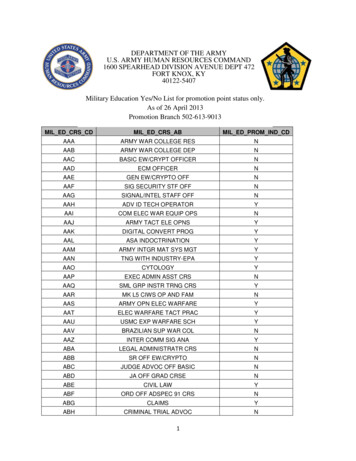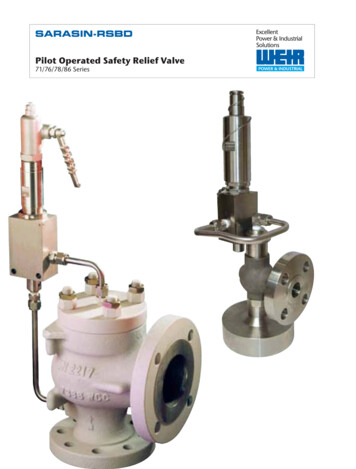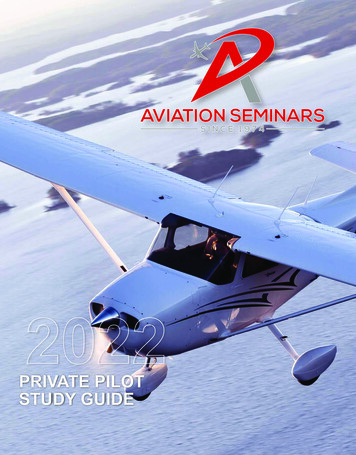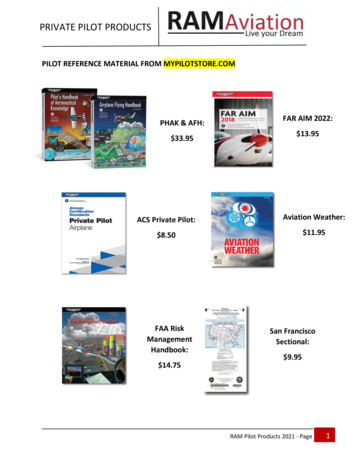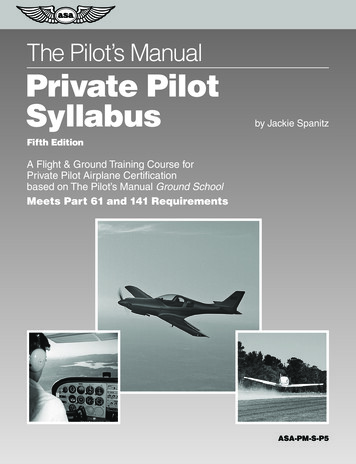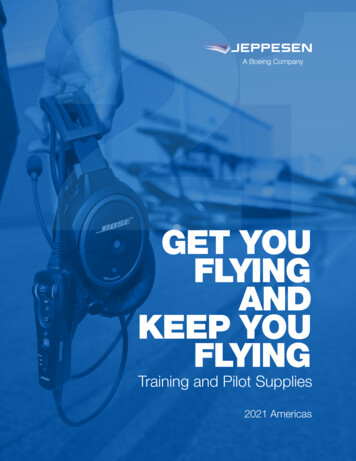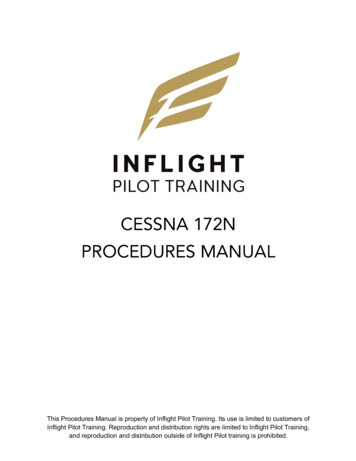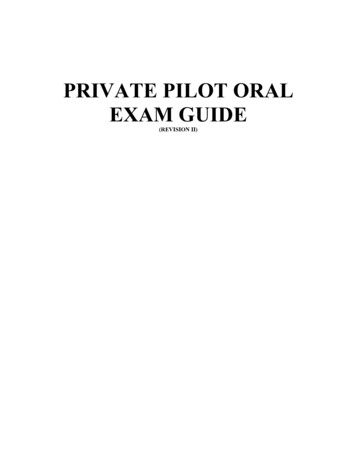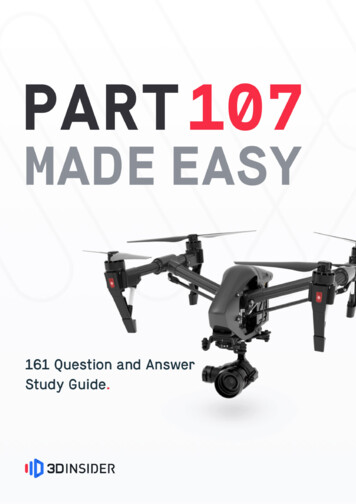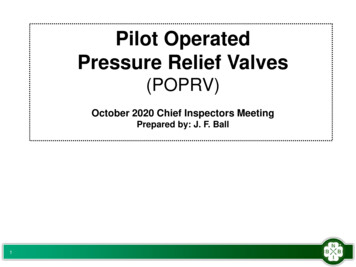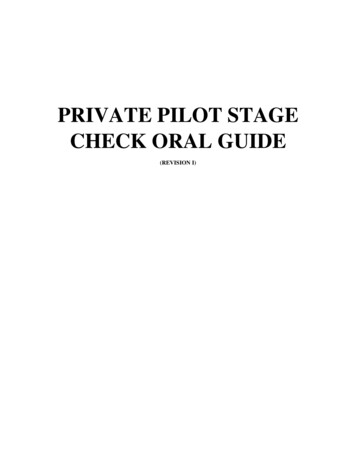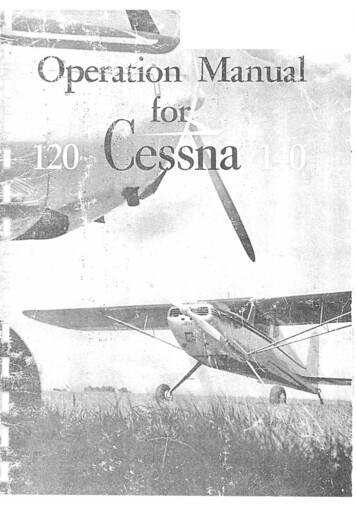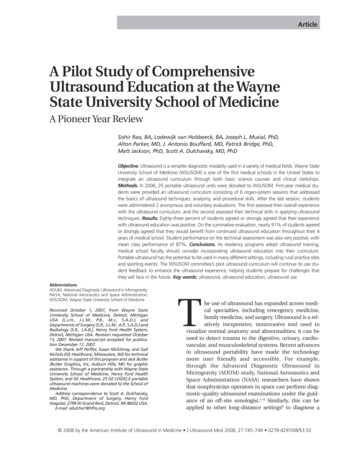
Transcription
27.5.jum.online.qxp:Layout 14/16/089:38 AMPage 745ArticleA Pilot Study of ComprehensiveUltrasound Education at the WayneState University School of MedicineA Pioneer Year ReviewSishir Rao, BA, Lodewijk van Holsbeeck, BA, Joseph L. Musial, PhD,Alton Parker, MD, J. Antonio Bouffard, MD, Patrick Bridge, PhD,Matt Jackson, PhD, Scott A. Dulchavsky, MD, PhDObjective. Ultrasound is a versatile diagnostic modality used in a variety of medical fields. Wayne StateUniversity School of Medicine (WSUSOM) is one of the first medical schools in the United States tointegrate an ultrasound curriculum through both basic science courses and clinical clerkships.Methods. In 2006, 25 portable ultrasound units were donated to WSUSOM. First-year medical students were provided an ultrasound curriculum consisting of 6 organ-system sessions that addressedthe basics of ultrasound techniques, anatomy, and procedural skills. After the last session, studentswere administered 2 anonymous and voluntary evaluations. The first assessed their overall experiencewith the ultrasound curriculum, and the second assessed their technical skills in applying ultrasoundtechniques. Results. Eighty-three percent of students agreed or strongly agreed that their experiencewith ultrasound education was positive. On the summative evaluation, nearly 91% of students agreedor strongly agreed that they would benefit from continued ultrasound education throughout their 4years of medical school. Student performance on the technical assessment was also very positive, withmean class performance of 87%. Conclusions. As residency programs adopt ultrasound training,medical school faculty should consider incorporating ultrasound education into their curriculum.Portable ultrasound has the potential to be used in many different settings, including rural practice sitesand sporting events. The WSUSOM committee’s pilot ultrasound curriculum will continue to use student feedback to enhance the ultrasound experience, helping students prepare for challenges thatthey will face in the future. Key words: ultrasound; ultrasound education; ultrasound use.AbbreviationsADUM, Advanced Diagnostic Ultrasound in Microgravity;NASA, National Aeronautics and Space Administration;WSUSOM, Wayne State University School of MedicineReceived October 1, 2007, from Wayne StateUniversity School of Medicine, Detroit, MichiganUSA (L.v.H., J.L.M., P.B., M.J., S.A.D.); andDepartments of Surgery (S.R., J.L.M., A.P., S.A.D.) andRadiology (S.R., J.A.B.), Henry Ford Health System,Detroit, Michigan USA. Revision requested October15, 2007. Revised manuscript accepted for publication December 17, 2007.We thank Jeff Peiffer, Susan McGilvray, and GailNichols (GE Healthcare, Milwaukee, WI) for technicalassistance in support of this program and Jack Butler(Butler Graphics, Inc, Auburn Hills, MI) for graphicassistance. Through a partnership with Wayne StateUniversity School of Medicine, Henry Ford HealthSystem, and GE Healthcare, 25 GE LOGIQ E portableultrasound machines were donated to the School ofMedicine.Address correspondence to Scott A. Dulchavsky,MD, PhD, Department of Surgery, Henry FordHospital, 2799 W Grand Blvd, Detroit, MI 48202 USA.E-mail: sdulcha1@hfhs.orgThe use of ultrasound has expanded across medical specialties, including emergency medicine,family medicine, and surgery. Ultrasound is a relatively inexpensive, noninvasive tool used tovisualize normal anatomy and abnormalities; it can beused to detect trauma to the digestive, urinary, cardiovascular, and musculoskeletal systems. Recent advancesin ultrasound portability have made the technologymore user friendly and accessible. For example,through the Advanced Diagnostic Ultrasound inMicrogravity (ADUM) study, National Aeronautics andSpace Administration (NASA) researchers have shownthat nonphysician operators in space can perform diagnostic-quality ultrasound examinations under the guidance of an off-site sonologist.1–5 Similarly, this can beapplied to other long-distance settings6 to diagnose a 2008 by the American Institute of Ultrasound in Medicine J Ultrasound Med 2008; 27:745–749 0278-4297/08/ 3.50
27.5.jum.online.qxp:Layout 14/16/089:38 AMPage 746Pilot Study of Comprehensive Ultrasound Educationvariety of medical conditions. For example, theADUM team has developed an ultrasound curriculum that trains nonexpert operators, including astronauts and Olympic sports trainers, inthe use of ultrasound in less than 3 hours ofdidactic instruction.For each specialty, varying ultrasound trainingstandards have been issued by residency reviewcommittees such as those of the American Collegeof Radiology, American College of EmergencyPhysicians, and American College of Cardiology.7–9Although there is no standardization of ultrasoundtraining among various specialties, it is importantthat medical educators prepare students for further ultrasound education in residency.10,11Wayne State University School of Medicine(WSUSOM) is the nation’s single largest medicalcampus, with 290 students per class in its allopathic MD program. The ADUM team, in collaboration with physicians of WSUSOM, adaptedthe NASA ultrasound curriculum to develop anexpanded program of study for WSUSOM.Wayne State University School of Medicine is 1 ofonly 2 medical schools in the nation to integratea comprehensive vertical ultrasound curriculumthroughout the preclinical and clinical years forthe class of 2010. This novel program aimed toincrease familiarization with the diagnostic andtherapeutic capabilities of ultrasound and highlight future clinical opportunities to use this versatile technology.Materials and MethodsIn 2006, 25 portable ultrasound machines weredonated to WSUSOM (Figure 1). A core group offaculty experts in ultrasound developed a standardized curriculum that was presented to thestudent body. The faculty was responsible forvertically integrated course development, modification of the courses based on feedback, andoutcomes analysis.The year 1 ultrasound curriculum consisted ofsix 90-minute sessions from October 2006 toMay 2007. Topics covered included abdominal,cardiovascular, genitourinary, and musculoskeletal ultrasound as well as the fundamentalsof ultrasound signal processing and proceduralskills (Table 1). The goal of each session was tofamiliarize the students with the ultrasound746machine, to expose them to normal anatomy,and to provide a foundation for ultrasound usefor detecting abnormalities in the clinical years.Although students were encouraged to participate in the ultrasound curriculum, attendancewas voluntary.Ultrasound sessions included didactic, hands-onexperience, and clinical correlation components.Each session began with all students attending alecture covering the prerequisite knowledge needed for their small-group classrooms. Students thenpracticed using the ultrasound technology. Facultyensured that all students demonstrated basic competency within their respective curriculum.Twenty-five portable ultrasound units were available for students to check out and practice withthroughout the academic year.The first-year medical student class of 290 students received a schedule and curriculum goalsbefore the start of the academic year. Studentsalso received a CD-ROM containing a multimedia Onboard Proficiency Enhancer, originallydeveloped for NASA ultrasound trials, whichaddressed topics such as the fundamentals ofultrasound, basic terminology, and a review ofhuman anatomy through the use of games andother interactive programs. The year 1 studentswere divided into 12 groups and, expert facultyinstructors were assigned. Faculty were assistedby Wayne State year 1 and year 2 medical studentassistants, who had volunteered to teach theirpeers and had participated in a review sessionwith the faculty before each ultrasound session.Figure 1. Portable ultrasound unit.J Ultrasound Med 2008; 27:745–749
27.5.jum.online.qxp:Layout 14/16/089:38 AMPage 747Rao et alTo assess the efficacy of the program, the facultyadministered 2 summative evaluations immediately after the last module. The first evaluationused a 5-point Likert scale (1, strongly disagree; 5,strongly agree) to assess students’ overall experience and satisfaction with the ultrasound curriculum during its pioneer year. Outcomes from thisevaluation are reported as minimum and maximum values, group mean and SD, and the percentage agreeing and strongly agreeing with thesurvey questions. The second evaluation assessedstudents’ skills. Specifically, students were exposedto pans filled with a dark gelatinlike composite thatcontained both grapes and shards of glass. Thisexercise simulated a clinical scenario involvingaspiration of liquid-filled cysts and localization offoreign bodies. Students were evaluated with a 9item dichotomous evaluation checklist, whichassessed students’ ability to (1) unfreeze thescreen, (2) appropriately place gel on the transducer, (3) understand the orientation of the probe andscreen (right versus left and superior versus inferior), (4) acquire an image of the foreign body andcorrectly identify the number and location, (5) calibrate appropriately (focus and depth), (6) measure the foreign body, (7) label the image, (8) hit theforeign body with a needle, and (9) save the image.A total of 9 points were possible. Outcomes arereported as frequency and group mean and SD.Faculty Assessment of Student SkillsTo evaluate the students’ skills with ultrasound,faculty assessed performance using a 1-page, 9item dichotomous (correct/incorrect) checksheet. Of the 110 (38%) students evaluated, overallstudent performance for each of the 9 itemsranged from 76% to 100% correct. The mean scorewas 7.83, and the median score was 8, whichequates to mean class performance of 87% correct. As shown in Figure 2, the histogram shows anegatively skewed distribution with 74 (67%) ofthe students scoring in the 89th percentile.Table 1. Wayne State University School of Medicine UltrasoundCurriculum, 2006–2007SessionObjectives1. Introduction to UltrasoundBasic ultrasound principlesUltrasound terminologyTransducer typesEssential keyboard controlsBasic ultrasound scanning techniquesDemonstrate ultrasound appearanceof muscle, tendon, bone, and nerveVisualization of forearm musclesVisualization of biceps tendonVisualization of midforearm radius andulna: transverse and longitudinalVisualization of median nerve andcarpal tunnelDemonstrate parasternal 4-chamberviews of the heartDemonstrate carotid artery/jugular veinimagesDiscuss M-mode and pulsed flowechocardiographyVisualization of carotid artery andjugular veinVisualization of aorta and vena cavaVisualization of 4-chamber viewVisualization of parasternal axisM-mode and pulsed field2. Musculoskeletal Ultrasound3. Vascular and Cardiac UltrasoundResultsStudents’ Overall Experience and SatisfactionWith the Ultrasound CurriculumThe 1-page, 7-item questionnaire used a 5-pointLikert scale (1, strongly disagree; 5, strongly agree)as well as 2 open-ended items. Of the 121 (42%)evaluations, the mean scores ranged from 3.82(question 1: Ultrasound education has enhancedmy understanding of human anatomy) to a meanscore of 4.37 (question 3: I will benefit from continued ultrasound education throughout my 4years of medical school). Four of the 5 rating itemshad a mean score of 4.1 or higher. Eighty-threepercent of students agreed or strongly agreed thattheir experience with ultrasound education waspositive. Nearly 91% of students agreed or strongly agreed that they would benefit from continuedultrasound education throughout their entiremedical curriculum (Table 2).J Ultrasound Med 2008; 27:745–7494. Ultrasound of the Abdomen5. Genitourinary Ultrasound6. Ultrasound and Procedural SkillsDemonstrate ultrasound appearanceof liver, kidney, gallbladder, spleen,bladder, bowel, and pancreasVisualization of liverVisualization of gallbladderVisualization of spleenDemonstrate ultrasound appearanceof bladder, kidney, and uretersVisualization of bladderVisualization of kidneyVisualization of uretersLocalization of foreign bodiesVisualization of internal jugular veinVisualization of radial arteryVisualization of needle in vascularspace747
27.5.jum.online.qxp:Layout 14/16/089:38 AMPage 748Pilot Study of Comprehensive Ultrasound EducationTable 2. Students’ Overall Experience and Satisfaction With the Ultrasound CurriculumQuestion1. Ultrasound education has enhanced my understandingof human anatomy.2. I plan to use portable ultrasound in my future clinicalpractice.3. I will benefit from continued ultrasound educationthroughout my 4 years of medical school.4. All medical schools should provide students withultrasound education.5. My experience with the ultrasound education was positive.nMinimumMaximumMean (SD)Students Agreeor StronglyAgree, %121153.82 (0.79)74120254.1 (0.76)82121254.37 (0.67)91121254.17 (0.68)86121154.12 (0.79)83DiscussionUltrasound appears to be a promising educational tool to train future physicians. Severalstudies have successfully experimented withultrasound education narrowly tailored to medical students. Students have been taught to useultrasound to improve anatomic knowledge,12 toaid in patient care in emergency department settings,7 to learn basic scanning techniques,13,14 toassist in cardiac15–18 and physical19 examinations,as part of a rural medical practice setting,20 andin a radiology core clerkship.21 This study documents a comprehensive vertical ultrasound curriculum that integrates didactic, hands-on, andclinical training in a medical school setting.Arguably, as the ultrasound curriculum progresses into its second year, students may find therole of ultrasound to be less abstract. For example,Figure 2. Faculty assessment of student skills with ultrasound.748second year students will begin to scan and recognize abnormalities in the connective tissue,cardiovascular, and neurology courses. Duringyear 3, the ultrasound curriculum will be interwoven with the core clinical clerkships, includingemergency medicine, internal medicine, obstetrics and gynecology, pediatrics, and surgery.During their fourth year, students will apply ultrasound in subspecialty fields, including ear, nose,and throat, intensive care unit medicine, neurosurgery, orthopedics, and urology.This pilot study from WSUSOM has shown thatstudents are enthusiastic about ultrasound technology and believe that they are benefiting fromparticipating in the ultrasound sessions. Moststudents who returned surveys have endorsedcontinued ultrasound education throughouttheir medical school education. Incorporatingultrasound into a medical school curriculum isbeneficial for increasing student knowledge andmay have a positive impact on patient carewhen the students progress on to their respective residencies. Most first-year medical students found the ultrasound sessions to beeffective teaching tools. Students performedexceedingly well on the ultrasound skills assessment, with most students placing in the top endof the score range with a mean score of 87%.According to Anastasi and Urbina,22 when basicskills are tested, 80% to 85% correct items wouldsuggest complete mastery.There were limitations to this pilot study. Thevoluntary nature of this ultrasound curriculummay help explain the 39% attrition from the firstto the sixth session. Scheduling problems (ie,during examination week) may have also led toJ Ultrasound Med 2008; 27:745–749
27.5.jum.online.qxp:Layout 14/16/089:38 AMPage 749Rao et aldecreased attendance, thus skewing outcomes.In addition, a pretest could have been conductedto assess actual knowledge gains (matchedpairs), but it was determined that few studentswould have knowledge of portable ultrasound,and with a limited number of assessment items,there was the potential of introducing a testingbias on the posttest, which would have been athreat to validity.Finally, incorporation of ultrasound educationinto the medical school curriculum is justemerging. With future innovations, ultrasoundmachines will become even more portable, perhaps even approaching the size of a personaldigital assistant. Such technology advancesbroaden the scope of ultrasound and make itpractical for use in a variety of venues, includingrural practices, the Olympics, and even outerspace. The need for ultrasound education is evident, and there is an opportunity for medicaleducators and medical school administrators topromote medical ultrasound education so thatthe next generation of physicians will be betterequipped to take advantage of this powerfuldiagnostic and therapeutic tool.8.Lanoix R, Baker WE, Mele JM, Dharmajan L. Evaluation ofan instructional model for emergency ultrasonography.Acad Emerg Med 1998; 5:58–63.9.Conti CR. The ultrasonic stethoscope: the new instrumentin cardiology? Clin Cardiol 2002; 25:547.10.Greenbaum LD. It is time for the sonoscope. J UltrasoundMed 2003; 22:321–322.11.Arger PH, Schultz SM, Sehgal CM, Cary TW, Aronchick J.Teaching medical students diagnostic sonography.J Ultrasound Med 2005; 24:1365–1369.12.Teichgräber UK, Meyer JM, Poulson Nautrup C, vonRautenfeld DB. Ultrasound anatomy: a practical teachingsystem in human gross anatomy. Med Educ 1996; 30:296–298.13.Fernández-Frackelton M, Peterson M, Lewis RJ, Pérez JE,Coates WC. A bedside ultrasound curriculum for medicalstudents: prospective evaluation of skill acquisition. TeachLearn Med 2007; 19:14–19.14.Yoo MC, Villegas L, Jones DB. Basic ultrasound curriculumfor medical students: validation of content and phantom.J Laparoendosc Adv Surg Tech A 2004; 14:374–379.15.Brunner M, Moeslinger T, Spieckermann PG. Echocardiographyfor teaching cardiac physiology in practical student courses. Am J Physiol 1995; 268:S2–S9.16.Decara JM, Kirkpatrick JN, Spencer KT, et al. Use of handcarried ultrasound devices to augment the accuracy ofmedical student bedside cardiac diagnoses. J Am SocEchocardiogr 2005; 18:257–263.References17.Duvall WL, Croft LB, Goldman ME. Can hand-carried ultrasound devices be extended for use by the noncardiologymedical community? Echocardiography 2003; 20:471–476.18.Wittich CM, Montgomery SC, Neben MA, et al. Teachingcardiovascular anatomy to medical students by using ahandheld ultrasound device. JAMA 2002; 288:1062–1063.19.Shapiro RS, Ko PK, Jacobson S. A pilot project to study theuse of ultrasonography for teaching physical examinationto medical students. Comput Biol Med 2002; 32:403–409.20.Mukundan S, Vydarey K, Vassallo DJ, Irving S, Ogaoga D.Trial telemedicine system for supporting medical studentson elective in the developing world. Acad Radiol 2003;10:794–797.21.Chew FS. Distributed radiology clerkship for the core clinical year of medical school. Acad Med 2002; 77:1162–1163.22.Anastasi A, Urbina S. Psychological Testing. 7th ed.Englewood Cliffs, NJ: Prentice Hall; 1997.1.Chiao L, Sharipov S, Sargsyan AE, et al. Ocular examinationfor trauma: clinical ultrasound aboard the InternationalSpace Station. J Trauma 2005; 58:885–889.2.Dulchavsky SA, Schwartz KL, Kirkpatrick AW, et al.Prospective evaluation of thoracic ultrasound in the detection of pneumothorax. J Trauma 2001; 50:201–205.3.Dulchavsky SA, Henry SE, Moed BR, et al. Advanced ultrasonic diagnoses of extremity trauma: the FASTER examination. J Trauma 2002; 53:28–32.4.Fincke EM, Padalka G, Lee D, et al. Evaluation of shoulderintegrity in space: first report of musculoskeletal US on theInternational Space Station. Radiology 2005; 234:319–322.5.McFarlin K, Sargsyan AE, Melton S, Hamilton DR,Dulchavsky SA. A surgeon’s guide to the universe. Surgery2006; 139:587–590.6.Kwon D, Bouffard JA, van Holsbeeck M, et al. Battling fireand ice: remote guidance ultrasound to diagnose injury onthe International Space Station and the ice rink. Am J Surg2007; 193:417–420.7.American College of Radiology. ACR standard for performing and interpreting diagnostic ultrasound examinations. In: Standards. Reston, VA: American College ofRadiology; 1996:235–236.J Ultrasound Med 2008; 27:745–749749
and sporting events. The WSUSOM committee's pilot ultrasound curriculum will continue to use stu-dent feedback to enhance the ultrasound experience, helping students prepare for challenges that they will face in the future. Key words:ultrasound; ultrasound education; ultrasound use. Received October 1, 2007, from Wayne State
